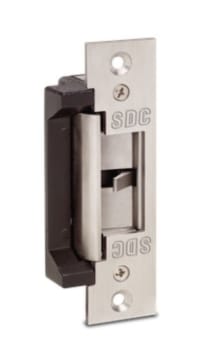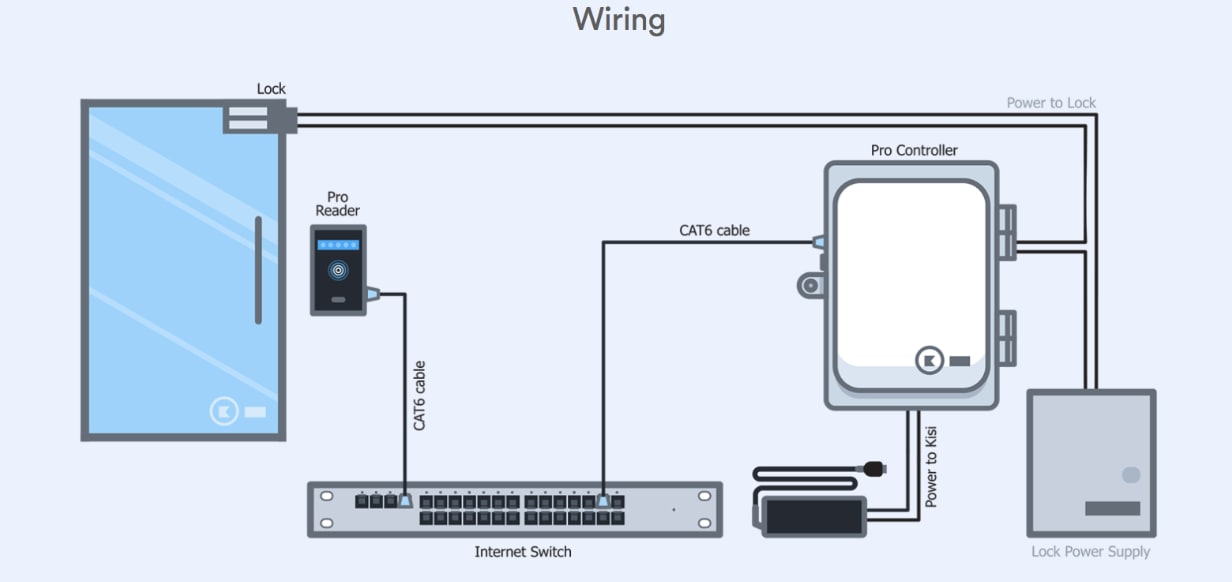For anyone looking to modernize from simple lock-and-key access methods, an electric lock is a great place to turn to. They’re more reliable and customizable than traditional methods, and can be integrated with modern access control for a much more flexible solution. In this article, we’ll delve into electric strike locks, one of the most popular options out there. For a broader introduction to the topic, check out our guide on electric locks.
How does an electric strike lock work?
In this section, we’ll explore the tech behind an electric strike lock, and see how to install it on premises.
What are the “moving parts” of an electric strike?
Electric strikes are similar to regular strike locks in that they are comprised of a strike that blocks the door latch. It’s installed at the level of a door handle, and is by far the most common electric lock you’ll find on metal or wooden doors. The main difference between it and a traditional strike door is that, as the name suggests, it’s electrified, and can be unlocked with electrical impulses. The impulse will also move the strike rather than the lock latch itself, as a key would do.

Fail-Safe or Fail-Secure Hybrid
One of the cool aspects of an electric strike lock is that it can be either fail-safe or fail-secure, depending on how you set it up. A fail-safe lock is unlocked when the power to it is cut, whereas a fail-secure lock is locked when power is out, and unlocked when it is fed power. In an electric strike, given that the moving parts are relatively simple and versatile, you can wire it so that the lock is either activated or deactivated based on whether it’s currently powered or not.

This makes it the ideal lock for any door on which it can be installed (not a glass door, as it needs to be in the frame). It’s simple to install, robust, and can function as an emergency exit route if wired in fail-safe mode.
How is it installed?
As mentioned, electric strike locks are relatively easy to install, as they generally just take the place of an existing strike lock. If not, though, you will need to cut out the mold in the wall, and drill it in. In terms of actual installation instructions, Kisi has a helpful video here of a standard electric strike install. You will also need to run wiring through the walls to a power source. The HES industrial electric strike is a good place to start your research for which lock to get for your space.
How can I test it?
As with any electronics you’re setting up in your space, you’ll want to make sure that you test them out before considering the installation done and dusted. With a lock this simple, it amounts to nothing more than connecting the wires, powering it up, and giving the right voltage to the strike (this varies based on the model, which is usually specified). At this point, it should trigger, and you’ll hear an audible “click.”
You might also consider testing a handful of unlocks in some “extreme” situations, like trying to open while yanking the door, trying to force it open without unlocking, things like that. While you might be hesitant to break your shiny new lock, it’s better to find these things out early while the installer is still around, than later when you have to deal with the issue yourself!
You should also test the connection to whichever access control system you’re connecting the lock to. The only reason you’d have an electric strike lock instead of an analog strike lock is if you have smart access control, so you’ll want to make sure everything is functioning properly in that area as well. More on this topic later in this article!
What else should I look out for during the install?
Beyond proper installation, you should be aware of certain compliance issues that might arise with respect to your new electric strike lock. Primarily, fire safety regulations demand that you be able to exit the building always in the case of an emergency, so this is generally not an issue linked to access control, but it’s still worth taking a moment to think about. Codes differ based on the city and the type of building. There are many commonalities, and Kisi has a handy guide to help you figure out what you need for your space.
In the same line as fire safety, if the electric strike lock is installed on a front door, or primary means of exiting the building (if it’s in fail-safe configuration), there ought to still be a way to operate the lock in case the power goes out. Even though the lock will stay open, you don’t want just anyone to be able to enter your space! Having a manual key override could be a worthwhile option to explore here, and something to discuss with your security installer.
Electronic locks for access control systems
Learn about different types of locks and their installation.
How is an electric strike unlocked using an access control system?
In this section we’ll give a basic overview of how electric strike locks work with the most modern IP access control readers like Kisi.
Wiring
On top of wiring your electric strike lock to a power supply, you will need to wire it to the access control controller or reader — most basic electric strikes don’t have wireless capabilities (by design!) The electric strike will either lock or unlock when prompted with an electrical impulse, and the access reader will govern these electrical impulses.

In this diagram, you can see the basic wiring for Kisi’s access control system with an electric lock. The one in the diagram is a magnetic lock, but the premise is the same for an electric strike. The reader receives the access credentials, sends them to the controller for authentication, and if they are approved, the controller tells the power supply to either give or cut off power to the lock, which opens the door.
Unlocking
If you opt for a modern IP access control system like Kisi’s unlocking can be done with a mobile device, or access cards if you prefer those. With the wiring described here, you will present your credentials, to the reader (tap your phone or access card to it), and the authentication process will begin.
Behind the scenes, at this point, the reader will take the Bluetooth or NFC signal from your phone and pass it along to the controller on a Bluetooth or WiFi signal. As mentioned in the previous section, if the controller authenticates the signal successfully, a signal will be sent to the lock power supply to either activate or cut off electricity to the lock, thus unlocking it for a short period of time.
Concluding Thoughts
Electric strike locks are a basic and reliable piece of hardware for anybody looking to get their feet wet with modern electronic access control. With a configurable fail-safe or fail-secure mechanism, they’re suitable for many different scenarios, and can easily be wired to any modern readers or controllers for a fully future-proof access solution.
Save time. Enhance security.
Modernize your access control with remote management and useful integrations.

